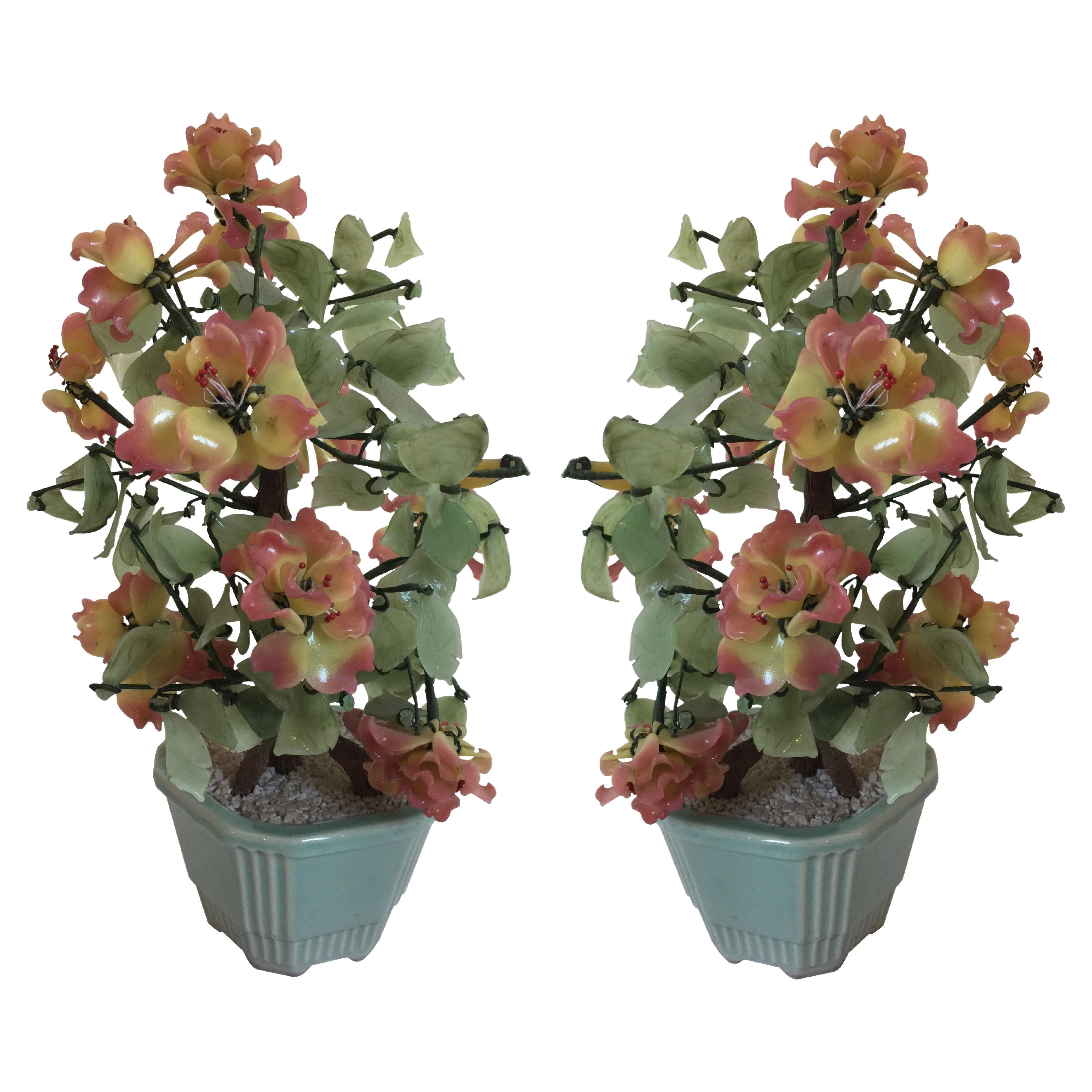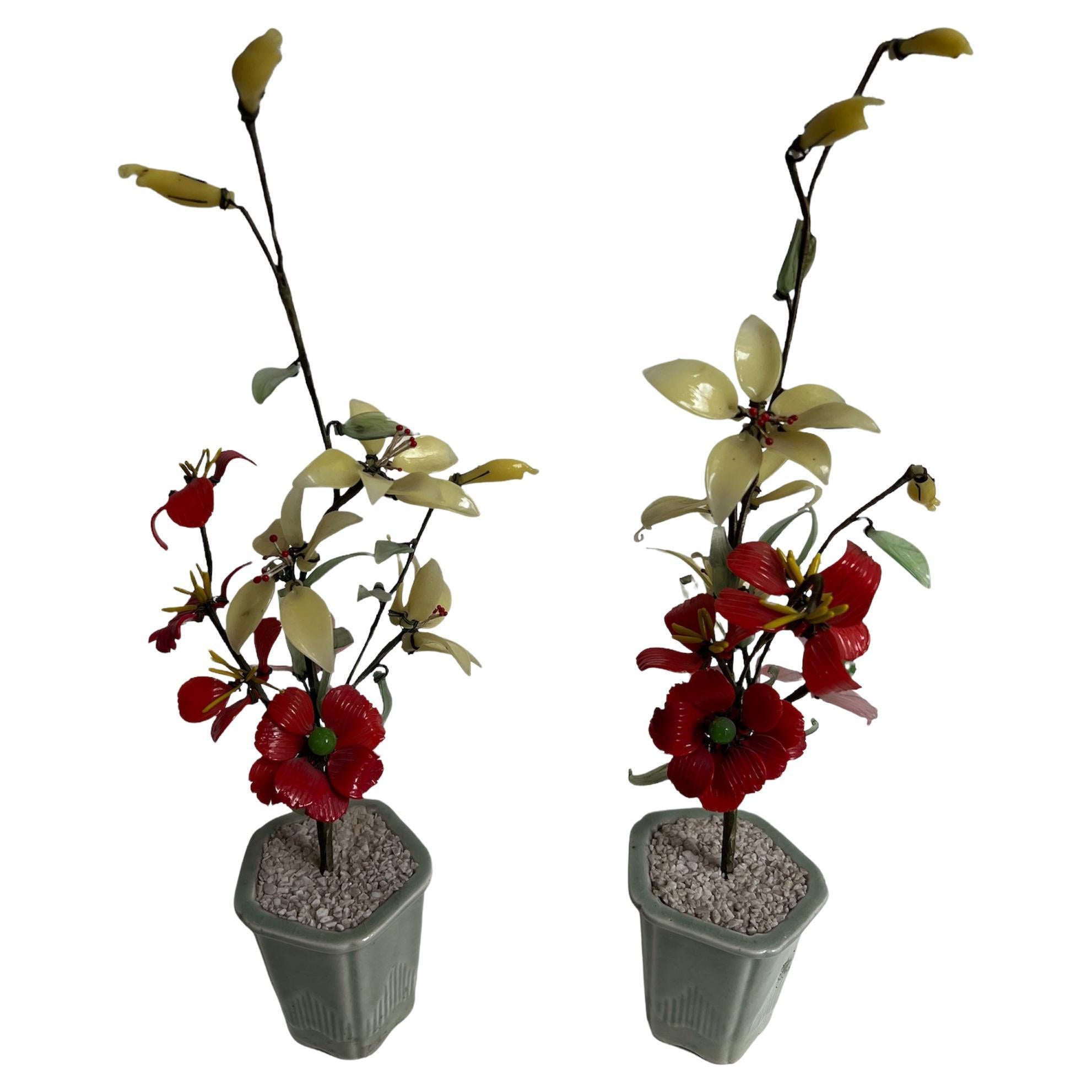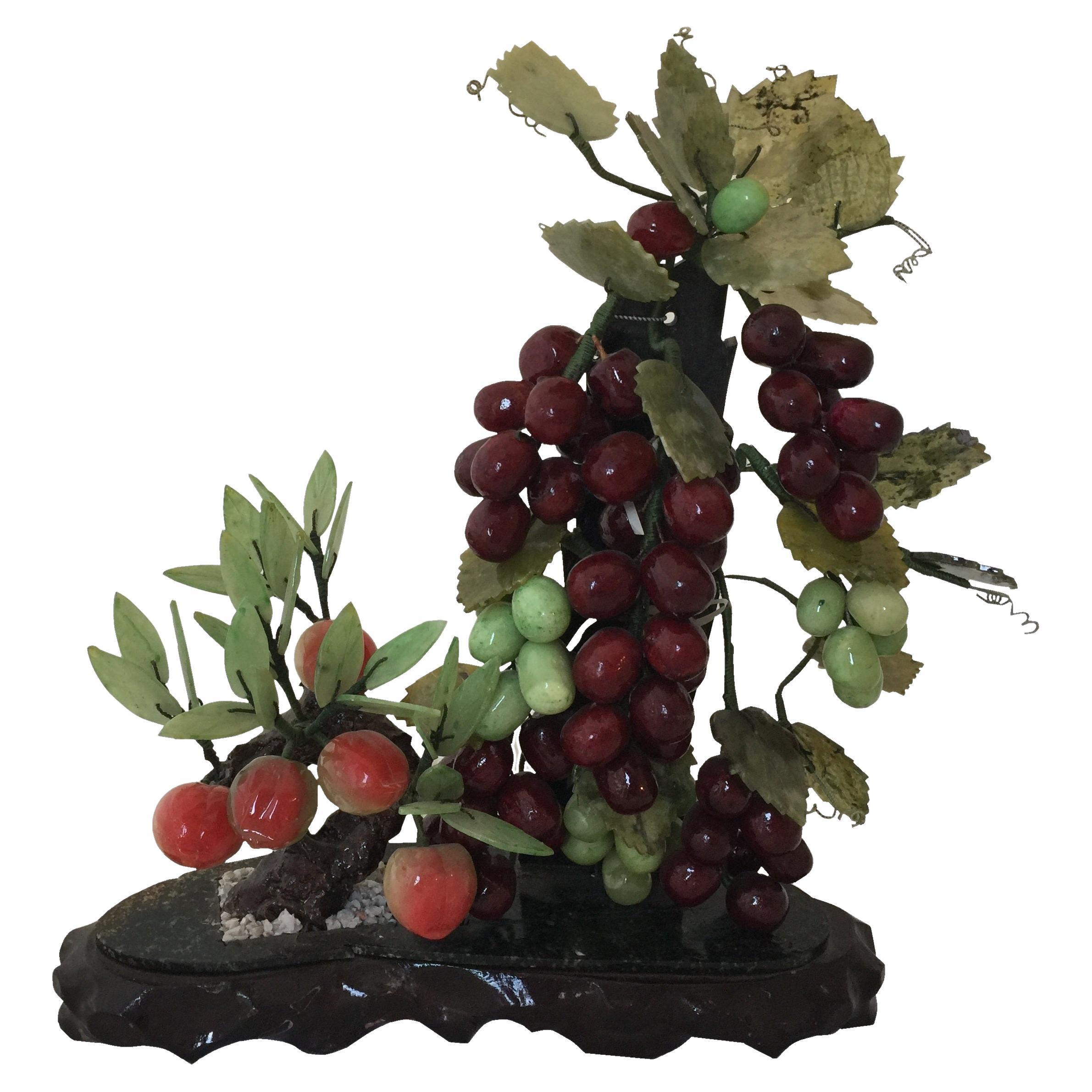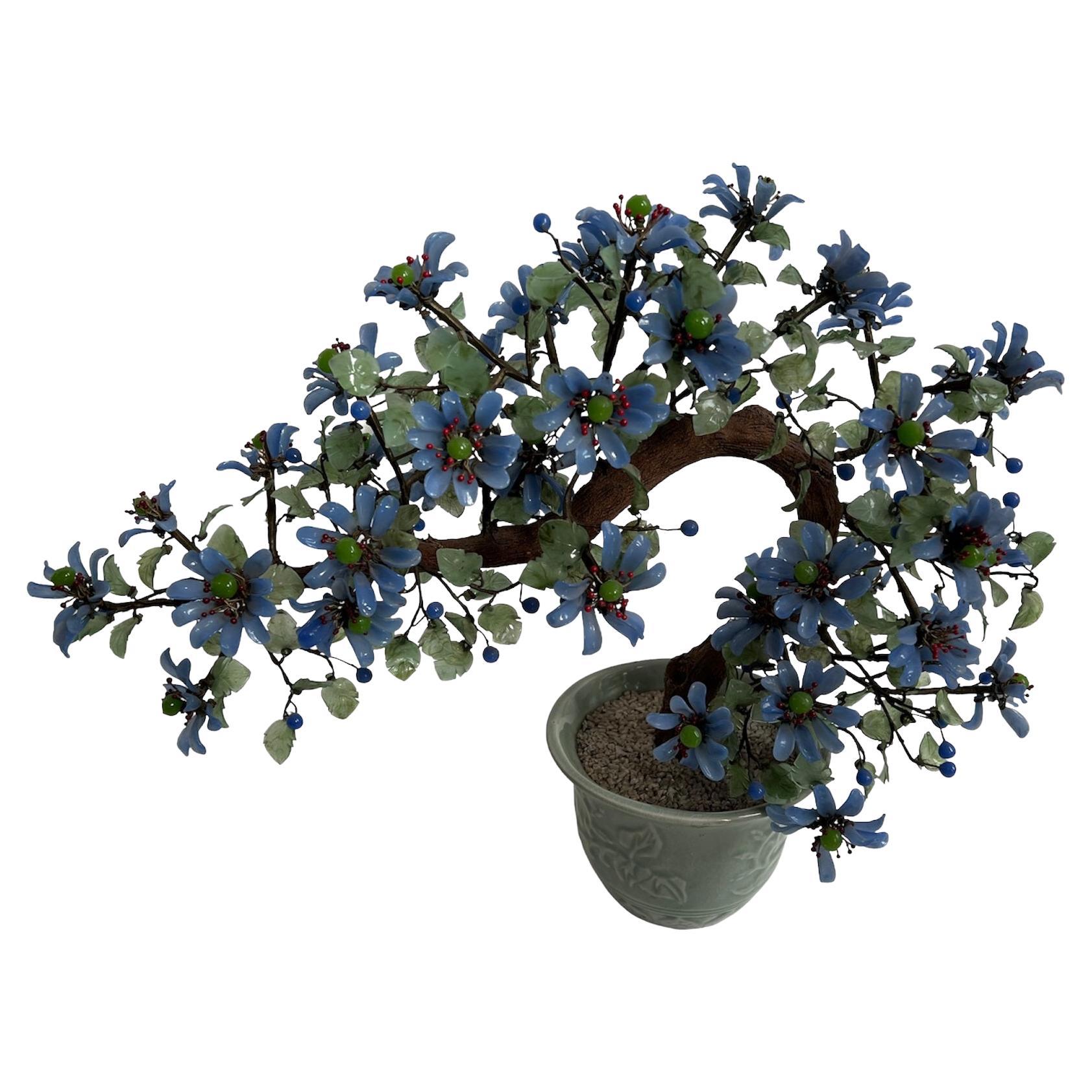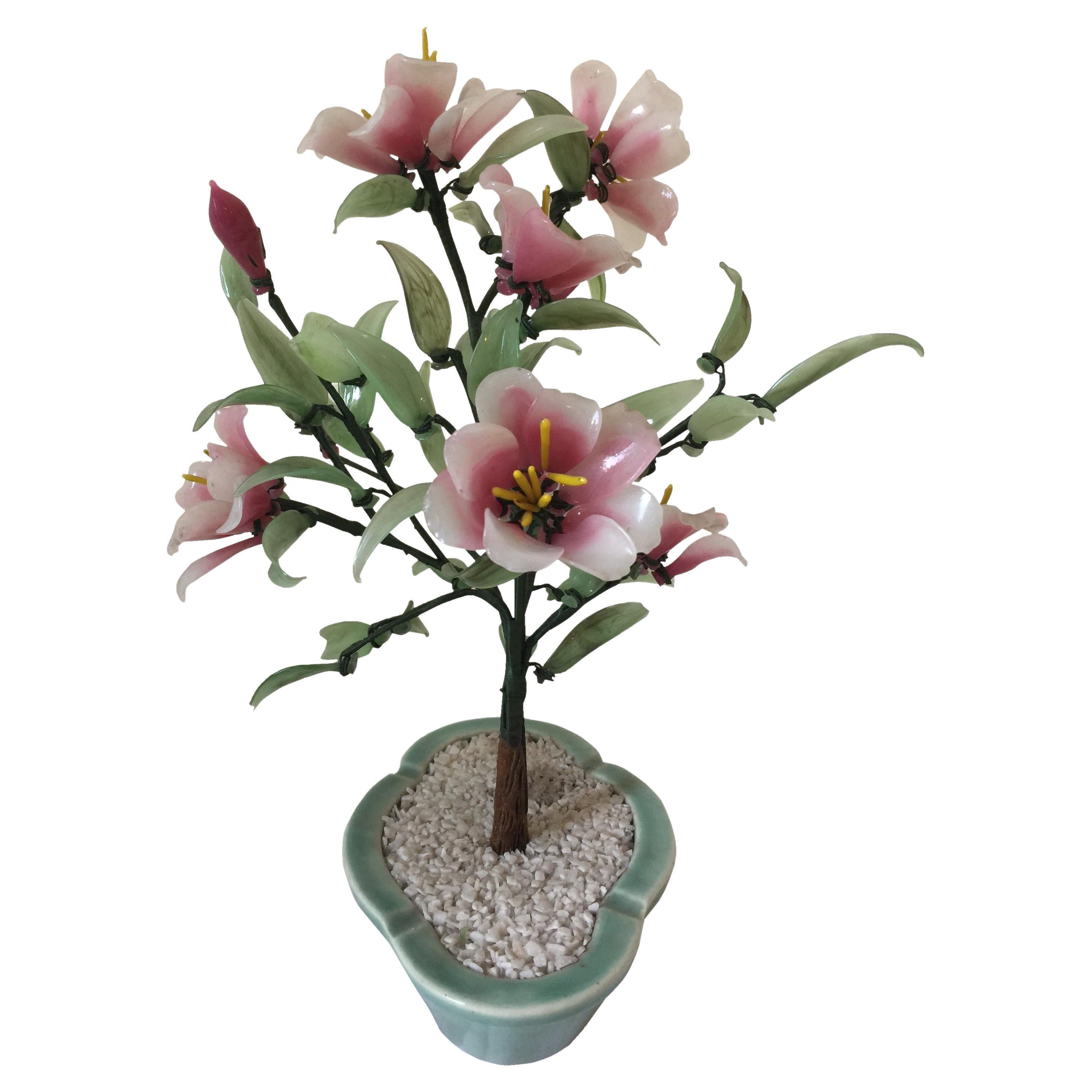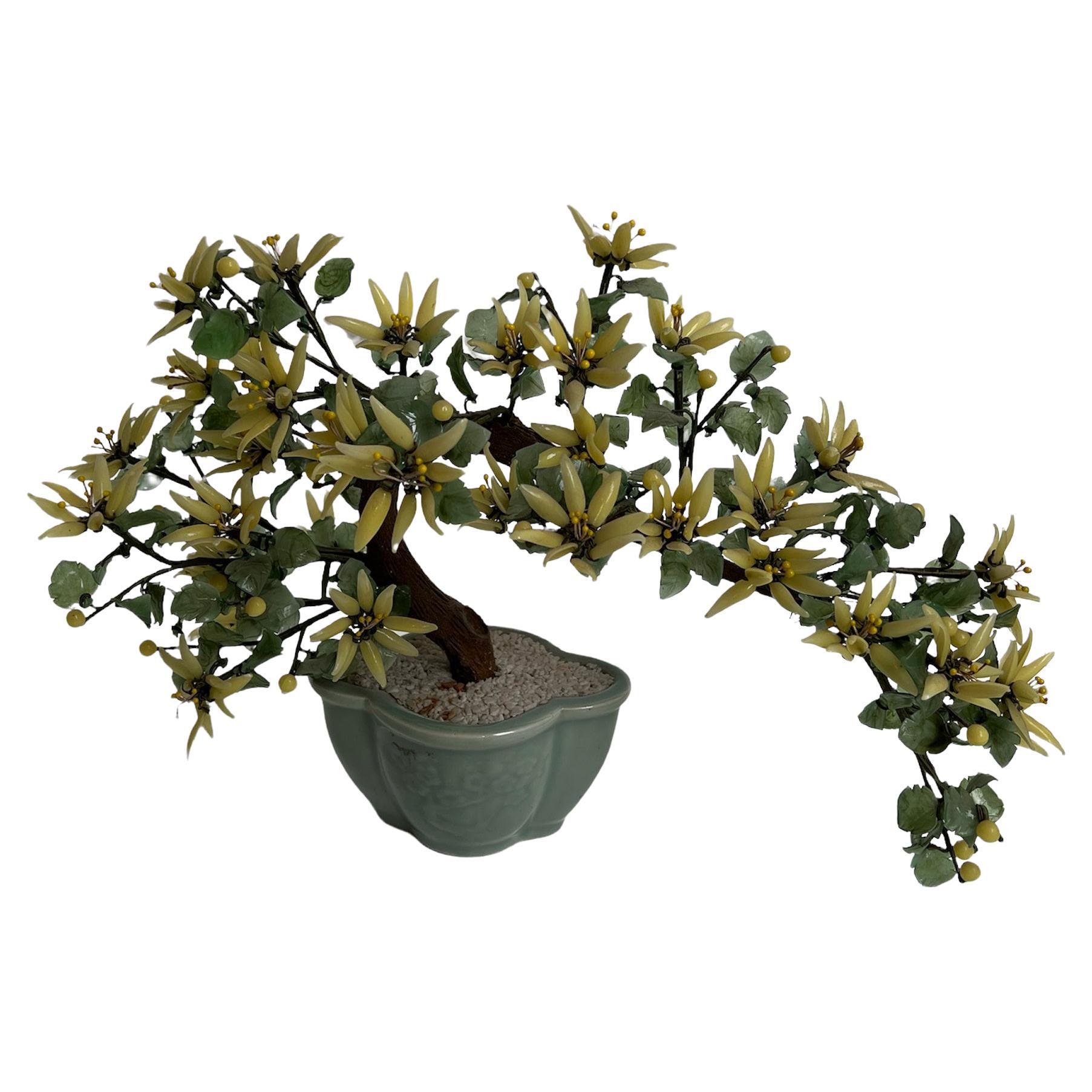Items Similar to Bonsai Blue 1980, Glass and Ceramic
Video Loading
Want more images or videos?
Request additional images or videos from the seller
1 of 17
Bonsai Blue 1980, Glass and Ceramic
About the Item
We have specialized in the sale of Art Deco and Art Nouveau and Vintage styles since 1982. If you have any questions we are at your disposal.
Pushing the button that reads 'View All From Seller'. And you can see more objects to the style for sale.
Why are there so many antiques in Argentina?
In the 1880 – 1940 there was a grate wave of immigration encouraged by the periods of war that were taking place.
1st World War took place between 1914 and 1918
2nd World War took place between 1939 and 1945
The immigrants options were New York or Buenos Aires. Tickets were cheap and in Buenos Aires they were welcomed with open arms, as it was a country where everything was still to be done.
Argentina was the country of new opportunities, labour was needed and religious freedom was assured, in many cases the of the family travel first until they were settled and then the rest of the family members join them.
In the immigrant museum “Ellis Island Immigrant Building” in New York you can se the promotional posters of the boats that would take them to a new life.
Between the years 1895 and 1896, Argentina had the highest DGP (gross domestic product) per capita in the world according to the Maddison Historical Statistics index, this situation arose due to the large amount of food being exported to European countries, which were at war.
The Argentinean ships left the port of Buenos Aires with food, but they returned with furniture, clothes and construction elements, (it´s common to see this the old buildings of the historic neighbourhood of San Telmo, the beams with the inscription “Made in England)”, as well as many markets that were built in Buenos Aires, such us the San Telmo Market, whose structure was brought by ship and afterwards assembled in 900 Defensa Street.
With the great influence of European immigrants living in the country, the children of the upper classes travelled to study in France, resulting in the inauguration of “La Maison Argentinienne”, on 27th of June 1928, in the international city of Paris, which hosted many Argentinians that were studying in Frace.
It´s the fourth house to be built after France, Canada and Belgium, being the first Spanish-speaking one. Still in place today (17 Bd Jourdan, 75014, Paris, France). Many of the children of these wealthy families who attended international art exhibitions, museums and art courses abroad, took a keen interest in the European style. This is why Buenos Aires was at the time referred as “The Paris of South America”.
Between the years 1890 and 1920 more than a hundred Palaces were built on Alvear Avenue the most exclusive avenue in Buenos Aires. Today some of these palaces have been transformed into museums, hotels and embassies.
In the year 1936, the Kavanagh building was inaugurated, it was the tallest reinforced concrete building in South America.
During 1994 the American Society of Civil Engineers distinguished it as an “international engineering milestone”, and it´s now considered a World Heritage of Modern Architecture.
At the time was common to hire foreign architects such as Le Corbusier, who visited Buenos Aires/Argentina in 1929 and in 1948 he drew up the blueprints for a house built in La Plata City (which was declared a World Heritage Site).
In 1947, the Hungarian architect Marcelo Breuer designed “Parador Ariston” in the seaside city of Mar del Plata. After an Argentinean student at Harvard University convinced him to come to Argentina. He worked on an urban development project in the Casa Amarilla, area of La Boca.
The Ukrainian architect, Vladimiro Acosta, arrives in Argentina in 1928 and worked as an architect until que moved to Brazil.
Antonio Bonet, a Spanish architect who worked with Le Corbusier in Paris, arrives in Argentina in 1937, where he carried out several architectural works and in 1938 designs the well-known BFK chair.
Andres Kálnay, of Hungarian origin, made around 120 architectural masterpieces, among which the former Munich brewery stands out, he even made the furniture’s design.
The German architect, Walter Gropius, director of the Bauhaus, lived in Argentina, where he wrote articles for “Sur” magazine and founded in Buenos Aires, an architectural firm with Franz Möller, who was also an architect, where he built two houses.
At the same time several famous designers decided to immigrate to Argentina, among them we can find the well-known French designer, Jean-Michel Frank, who arrived in the country in 1940 and also worked for the Rockefeller family.
Special pieces were made, which were sold exclusively in the country, such as the well-known German company “WMF”, who sold their products by catalogue, which were chosen by the ladies of High Society in the list of wedding gifts, as well as the pieces designed by Christofle.
The Swiss sculptor Alberto Giacometti, made special pieces for Argentinean mansions.
In 1904 the first Jansen branch outside Paris was established in Buenos Aires, as the Argentinean clientele demanded a large amount of furniture, from the end of the 19th Century to the mid-20th Century.
In 1970, the brand Rigolleau Argentina made pieces authorised by Lalique.
The brands Maple and Thompson also set up shop in the country.
The French plastic artist, Marcel Duchamp moved to Argentina in 1918-1919.
Glass signed Gallé, Charder, Leverre, Schneider, Muller and other French firms. They were bought in flower shops and were given to ladies with beautiful floral arrangements.
Some furniture manufacturers travelled to international fairs and bough the patterns to produce the furniture in Argentina, such as the furniture firm Englander and Bonta, who bought the patterns ins Italy.
It is worth mentioning that in Argentina we have the largest Community of Italians outside of Italy, as it is estimated that 70 percent of the inhabitants have at least one Italian descendant, followed by Spanish immigrants.
The most Important furniture stores in Argentina:
Comte is founded in 1934 (under the direct management of Jean Michel Frank in 1940).
Nordiska (Swedish company established in 1934).
Churba in 1960, a company that brought foreign designers to present their furniture in the country:
Denmark: (Arne Jacobsen, Finn Juhl, Bender Madsen, Ejner Larsen, Poul Kjaerholm, Hans Wegner)
Sweden: (Hans Agne Jakobsson, Gustavsberg)
United States: (Herman Miller)
Finland: (Lisa Johansson, Folke Arstrom, Tapio Wirkkala, Alvar Aalto, Timo Sarpaneva)
Swedish Factory: (Orrefors)
Italy: (Littala, Vico Magistretti, Emma Gismondi, Gae Aulenti, Angelo Mangiarotti, Elio Martinelli, Gianna Celada, Angelo Mangiarotti, Mario Bellini, Carlo Scarpa)
Finland: (Olivia Toikka)
Plata Lappas (Lappas Silver): a goldsmith shop founded in 1887 in Argentina by Alcibiades Lappas of Greek origin.
In 2019, in Argentina took place “the Art Deco world congress”, in which we participated as hosts invited by Geo Darder, founder of the Copperbridge – Foundation, in which prominent people from all over the world attended to learn about Art Deco in Argentina.
Argentina currently has more than 100 Art Deco buildings and another 90 Art Nouveau buildings throughout the city of Buenos Aires.
Argentina is a country that has not been involved in many wars, which is why it has been a refuge for works of art and antiques from different periods of time, unlike European countries. That is way many collectors, museums and antique dealers from all over the world visit it, you should not miss the opportunity to visit this great country.
Laura Guevara Kjuder, architect.
.
- Dimensions:Height: 11.82 in (30 cm)Width: 15.75 in (40 cm)Depth: 7.88 in (20 cm)
- Style:Mid-Century Modern (In the Style Of)
- Materials and Techniques:
- Place of Origin:
- Period:1980-1989
- Date of Manufacture:1980
- Condition:Wear consistent with age and use.
- Seller Location:Ciudad Autónoma Buenos Aires, AR
- Reference Number:
About the Seller
5.0
Vetted Seller
These experienced sellers undergo a comprehensive evaluation by our team of in-house experts.
Established in 1982
1stDibs seller since 2022
21 sales on 1stDibs
Typical response time: <1 hour
- ShippingRetrieving quote...Ships From: Ciudad Autónoma Buenos Aires, Argentina
- Return PolicyThis item cannot be returned.
More From This SellerView All
- Pair of Bonsai 1980, Glass and CeramicLocated in Ciudad Autónoma Buenos Aires, CWe have specialized in the sale of Art Deco and Art Nouveau and Vintage styles since 1982. If you have any questions we are at your disposal. Pushing the button that reads 'View All ...Category
Vintage 1980s Japanese Mid-Century Modern Planters, Cachepots and Jardin...
MaterialsArt Glass, Ceramic
- Pair of Bonsai, Glass and Ceramic, 1980Located in Ciudad Autónoma Buenos Aires, CWe have specialized in the sale of Art Deco and Art Nouveau and Vintage styles since 1982. If you have any questions we are at your disposal. Pushing the button that reads 'View All ...Category
Vintage 1980s Japanese Mid-Century Modern Planters, Cachepots and Jardin...
MaterialsCeramic, Art Glass
- Bonsai 1980, Glass and WoodLocated in Ciudad Autónoma Buenos Aires, CWe have specialized in the sale of Art Deco and Art Nouveau and Vintage styles since 1982. If you have any questions we are at your disposal. Pushing the button that reads 'View All ...Category
Vintage 1980s Japanese Mid-Century Modern Planters, Cachepots and Jardin...
MaterialsArt Glass, Wood
- Big Bonsai, Glass and CeramicLocated in Ciudad Autónoma Buenos Aires, CWe have specialized in the sale of Art Deco and Art Nouveau and Vintage styles since 1982. If you have any questions we are at your disposal. Pushing the button that reads 'View All From Seller'. And you can see more objects to the style for sale. Why are there so many antiques in Argentina? In the 1880 – 1940 there was a grate wave of immigration encouraged by the periods of war that were taking place. 1st World War took place between 1914 and 1918 2nd World War took place between 1939 and 1945 The immigrants options were New York or Buenos Aires. Tickets were cheap and in Buenos Aires they were welcomed with open arms, as it was a country where everything was still to be done. Argentina was the country of new opportunities, labour was needed and religious freedom was assured, in many cases the of the family travel first until they were settled and then the rest of the family members join them. In the immigrant museum “Ellis Island Immigrant Building” in New York you can se the promotional posters of the boats that would take them to a new life. Between the years 1895 and 1896, Argentina had the highest DGP (gross domestic product) per capita in the world according to the Maddison Historical Statistics index, this situation arose due to the large amount of food being exported to European countries, which were at war. The Argentinean ships left the port of Buenos Aires with food, but they returned with furniture, clothes and construction elements, (it´s common to see this the old buildings of the historic neighbourhood of San Telmo, the beams with the inscription “Made in England)”, as well as many markets that were built in Buenos Aires, such us the San Telmo Market, whose structure was brought by ship and afterwards assembled in 900 Defensa Street. With the great influence of European immigrants living in the country, the children of the upper classes travelled to study in France, resulting in the inauguration of “La Maison Argentinienne”, on 27th of June 1928, in the international city of Paris, which hosted many Argentinians that were studying in Frace. It´s the fourth house to be built after France, Canada and Belgium, being the first Spanish-speaking one. Still in place today (17 Bd Jourdan, 75014, Paris, France). Many of the children of these wealthy families who attended international art exhibitions, museums and art courses abroad, took a keen interest in the European style. This is why Buenos Aires was at the time referred as “The Paris of South America”. Between the years 1890 and 1920 more than a hundred Palaces were built on Alvear Avenue the most exclusive avenue in Buenos Aires. Today some of these palaces have been transformed into museums, hotels and embassies. In the year 1936, the Kavanagh building was inaugurated, it was the tallest reinforced concrete building in South America. During 1994 the American Society of Civil Engineers distinguished it as an “international engineering milestone”, and it´s now considered a World Heritage of Modern Architecture. At the time was common to hire foreign architects such as Le Corbusier, who visited Buenos Aires/Argentina in 1929 and in 1948 he drew up the blueprints for a house built in La Plata City (which was declared a World Heritage Site). In 1947, the Hungarian architect Marcelo Breuer designed “Parador Ariston” in the seaside city of Mar del Plata. After an Argentinean student at Harvard University convinced him to come to Argentina. He worked on an urban development project in the Casa Amarilla, area of La Boca. The Ukrainian architect, Vladimiro Acosta, arrives in Argentina in 1928 and worked as an architect until que moved to Brazil. Antonio Bonet, a Spanish architect who worked with Le Corbusier in Paris, arrives in Argentina in 1937, where he carried out several architectural works and in 1938 designs the well-known BFK chair. Andres Kálnay, of Hungarian origin, made around 120 architectural masterpieces, among which the former Munich brewery stands out, he even made the furniture’s design. The German architect, Walter Gropius, director of the Bauhaus, lived in Argentina, where he wrote articles for “Sur” magazine and founded in Buenos Aires, an architectural firm with Franz Möller, who was also an architect, where he built two houses. At the same time several famous designers decided to immigrate to Argentina, among them we can find the well-known French designer, Jean-Michel Frank, who arrived in the country in 1940 and also worked for the Rockefeller family. Special pieces were made, which were sold exclusively in the country, such as the well-known German company “WMF”, who sold their products by catalogue, which were chosen by the ladies of High Society in the list of wedding gifts, as well as the pieces designed by Christofle. The Swiss sculptor Alberto Giacometti, made special pieces for Argentinean mansions. In 1904 the first Jansen branch outside Paris was established in Buenos Aires, as the Argentinean clientele demanded a large amount of furniture, from the end of the 19th Century to the mid-20th Century. In 1970, the brand Rigolleau Argentina made pieces authorised by Lalique. The brands Maple and Thompson also set up shop in the country. The French plastic artist, Marcel Duchamp moved to Argentina in 1918-1919. Glass signed Gallé, Charder, Leverre, Schneider, Muller and other French firms. They were bought in flower shops and were given to ladies with beautiful floral arrangements. Some furniture manufacturers travelled to international fairs and bough the patterns to produce the furniture in Argentina, such as the furniture firm Englander and Bonta, who bought the patterns ins Italy. It is worth mentioning that in Argentina we have the largest Community of Italians outside...Category
Vintage 1980s Japanese Mid-Century Modern Planters, Cachepots and Jardin...
MaterialsArt Glass, Ceramic
- Bonsai Pink 1980, Glass and WoodLocated in Ciudad Autónoma Buenos Aires, CWe have specialized in the sale of Art Deco and Art Nouveau and Vintage styles since 1982. If you have any questions we are at your disposal. Pushing the button that reads 'View All ...Category
Vintage 1980s Japanese Mid-Century Modern Planters, Cachepots and Jardin...
MaterialsArt Glass, Wood
- Big Yellow Bonsai, Glass and CeramicLocated in Ciudad Autónoma Buenos Aires, CWe have specialized in the sale of Art Deco and Art Nouveau and Vintage styles since 1982. If you have any questions we are at your disposal. Pushing the button that reads 'View All ...Category
Vintage 1980s Japanese Mid-Century Modern Planters, Cachepots and Jardin...
MaterialsCeramic, Art Glass
You May Also Like
- Weller Pottery Blue Iridescent Glass and Ceramic VaseLocated in North Miami, FLWeller Pottery, founded in 1872 in Fultonham, Ohio, established its roots in the world of art pottery. In 1882, the company relocated to Zanesville, Ohio, marking a pivotal moment in its history. By 1893, Weller Pottery had ventured into the realm of artwares, broadening its creative horizons. Remarkably, by 1915, Weller Pottery had emerged as the preeminent leader in the global art pottery industry, a testament to its dedication to craftsmanship and innovation. One exquisite example of their artistry is the 1910s blue iridescent glass...Category
20th Century Vases
MaterialsCeramic, Glass
- Design Murano Glass Blue Sphere by Alberto Donà, Italy 1980sBy Alberto DonàLocated in Villaverla, ITDesign Murano Glass Blue Sphere by Alberto Donà, Italy, 1980s. This unique artwork is simply outstanding. A vintage masterpiece by the renowned It...Category
Vintage 1980s Italian Modern Abstract Sculptures
MaterialsGlass, Art Glass, Blown Glass, Cut Glass, Murano Glass
- Alfredo Barbini, Aquamarine Incalmo Vase Murano Glass 1980s, Signed and LabeledBy Alfredo BarbiniLocated in Tavarnelle val di Pesa, FlorenceFine vessel made in Murano by Alfredo Barbini. This vase is made in two colors, aquamarine and transparent. Colors are joined with the incalmo technique, one of the most difficult in...Category
Late 20th Century Italian Mid-Century Modern Vases
MaterialsArt Glass, Murano Glass
- Mario Badioli after Picasso Black and Orange Sommerso Murano Glass Vase, 1980sLocated in Roma, ITMidcentury amazing black and orange sommerso Murano glass vase. Mario Badioli probably designed this fantastic piece in the style of Picasso in Italy dur...Category
Mid-20th Century Italian Mid-Century Modern Vases
MaterialsGlass, Art Glass, Murano Glass
- Abstract Ceramic Studio Pottery Vase Object Horst Kerstan, Kandern Germany 1980sBy Horst KerstanLocated in Kirchlengern, DEArticle: Ceramic stoneware object Designer and producer: Horst Kerstan, Kandern in Germany Information: Horst Kerstan (born March 29, 1941 in Frankfurt, † March 21, 2005 in Kandern) was a German ceramist, craftsman and internationally recognized artist. Founder of Group 83. Decade: 1980s This original vintage Studio Stoneware Object was designed by Horst Kerstan and produced in his own Studio in the 1980s in Kandern in Germany. It is made of solid stoneware pottery and has a very unique red brown beige coloration and structure. the bottom is marked with typical Kerstan Producer signature K and signed with Keratin and date 21.9.1980. a very collectible and very rare item of the Kerstan Collection. the object has a very sculptural form and in its size of 17x18cm, it is very impressive. straighforward and minimalistic design of the 1980s design era. This item is a wonderful addition to every modern home. Dimensions: Height 17cm Length 17cm Depth 18cm. Condition: This item is in a very good vintage condition with patina. VITA Horst Kerstan: Horst Kerstan grew up in Frankfurt am Main, where he became acquainted with the manufacture of ceramic products through his father Walter Kerstan, who headed the "Ceramic Colors" department of Farbwerke Hoechst AG. After a porcelain painter apprenticeship, he worked from 1956 to 1957 as a porcelain painter in the porcelain manufactory of Hoechst AG, then from 1957 to 1959 in the ceramics department of the Werkkunstschule Offenbach (today: Hochschule für Gestaltung Offenbach am Main) with Lore Kramer-Koehn, the wife of Frankfurt architect Ferdinand Kramer, the pottery to learn and incidentally at the College of Fine Arts, Frankfurt, the drawing. After Kerstan met the ceramist and painter Richard Bampi...Category
Late 20th Century German Mid-Century Modern Vases
MaterialsCeramic, Pottery, Stoneware
- Set of 2 Ceramic Studio Pottery Vase by Gerhard Liebenthron, Germany, 1980sBy Gerhard LiebenthronLocated in Kirchlengern, DEArticle: Ceramic stoneware object set of 2 Designer and producer: Gerhard Liebenthron Information: Gerhard Liebenthron, Bremen 1925-2005 Decade: 1970s and 198...Category
Late 20th Century German Mid-Century Modern Vases
MaterialsCeramic, Pottery, Stoneware
Recently Viewed
View AllMore Ways To Browse
Vintage 1980 Glass
1980 Pattern
Ceramic House
70s Glass Objects
Vintage 1980 Gifts
Ceramic Ship
Architecture Buenos Aires
Retro Glass Button
90s Japanese
La Boca
Sale Japanese
European Mid Century Port
20th Mid Century Poster Design
Mid Century Brazil Antiques
Foreign Objects Vintage
Flower Shop Vintage
Two Modern Gropius
Vintage Travel Poster Mid Century
